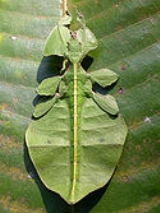
Phylliidae
Encyclopedia
The family Phylliidae contains the extant true leaf insects or walking leaves, which include some of the most remarkable leaf mimics in the entire animal kingdom. They occur from South Asia
through Southeast Asia
to Australia
. At present, there is no consensus as to the preferred classification of this group; some sources treat Phylliidae as a much larger taxon, containing the members of what are presently considered to be several different families.
to take on the appearance of a leaf. They do this so accurately that predators often aren't able to distinguish them from real leaves. In some species the edge of the leaf insect's body even has the appearance of bite marks. To further confuse predators, when the leaf insect walks, it rocks back and forth, to mimic a real leaf being blown by the wind.
The scholar Antonio Pigafetta
may have been the first to document the creature. Sailing with Ferdinand Magellan
's circumnavigation
al expedition, he studied and chronicled the fauna
on the island
of Cimbonbon as the fleet hauled ashore for repairs. During this time he documented the Phyllium species with the following passage:
South Asia
South Asia, also known as Southern Asia, is the southern region of the Asian continent, which comprises the sub-Himalayan countries and, for some authorities , also includes the adjoining countries to the west and the east...
through Southeast Asia
Southeast Asia
Southeast Asia, South-East Asia, South East Asia or Southeastern Asia is a subregion of Asia, consisting of the countries that are geographically south of China, east of India, west of New Guinea and north of Australia. The region lies on the intersection of geological plates, with heavy seismic...
to Australia
Australia
Australia , officially the Commonwealth of Australia, is a country in the Southern Hemisphere comprising the mainland of the Australian continent, the island of Tasmania, and numerous smaller islands in the Indian and Pacific Oceans. It is the world's sixth-largest country by total area...
. At present, there is no consensus as to the preferred classification of this group; some sources treat Phylliidae as a much larger taxon, containing the members of what are presently considered to be several different families.
Characteristics
Leaf insects use camouflageCamouflage
Camouflage is a method of concealment that allows an otherwise visible animal, military vehicle, or other object to remain unnoticed, by blending with its environment. Examples include a leopard's spotted coat, the battledress of a modern soldier and a leaf-mimic butterfly...
to take on the appearance of a leaf. They do this so accurately that predators often aren't able to distinguish them from real leaves. In some species the edge of the leaf insect's body even has the appearance of bite marks. To further confuse predators, when the leaf insect walks, it rocks back and forth, to mimic a real leaf being blown by the wind.
The scholar Antonio Pigafetta
Antonio Pigafetta
Antonio Pigafetta was an Italian scholar and explorer from the Republic of Venice. He travelled with the Portuguese explorer Ferdinand Magellan and his crew on their voyage to the Indies. During the expedition, he served as Magellan's assistant and kept an accurate journal which later assisted him...
may have been the first to document the creature. Sailing with Ferdinand Magellan
Ferdinand Magellan
Ferdinand Magellan was a Portuguese explorer. He was born in Sabrosa, in northern Portugal, and served King Charles I of Spain in search of a westward route to the "Spice Islands" ....
's circumnavigation
Circumnavigation
Circumnavigation – literally, "navigation of a circumference" – refers to travelling all the way around an island, a continent, or the entire planet Earth.- Global circumnavigation :...
al expedition, he studied and chronicled the fauna
Fauna
Fauna or faunæ is all of the animal life of any particular region or time. The corresponding term for plants is flora.Zoologists and paleontologists use fauna to refer to a typical collection of animals found in a specific time or place, e.g. the "Sonoran Desert fauna" or the "Burgess shale fauna"...
on the island
Island
An island or isle is any piece of sub-continental land that is surrounded by water. Very small islands such as emergent land features on atolls can be called islets, cays or keys. An island in a river or lake may be called an eyot , or holm...
of Cimbonbon as the fleet hauled ashore for repairs. During this time he documented the Phyllium species with the following passage:

